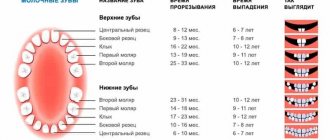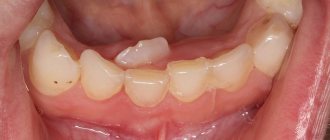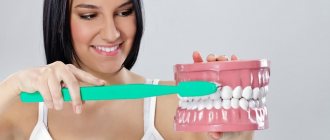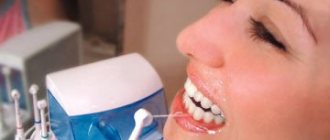Symptoms that indicate that the process has begun:
- Some children experience an increase in temperature (up to 38). In this case, you should not hesitate; it is better to seek advice from your doctor.
- Unpleasant sensations in the gums.
- The space between the teeth increases.
- The roots begin to dissolve (The roots of baby teeth are much shorter than those of permanent teeth. When the process reaches the neck, a tooth change occurs).
- Gums are bleeding.
Everything has its time
One of the most frequently asked questions to our doctors from mothers is: “In what order do teeth begin to fall out?”
It usually starts at the age of 5 years. The very first teeth that undergo this process are the incisors, then the fourth and fifth teeth of the row, then the canines. To make it more clear to you, here is a diagram of the loss and eruption of baby teeth:
Don't worry if your child is over 5 years old and his teeth aren't starting to change. Each child’s body is individual, and much depends on nutrition, dental care, daily routine, and climatic conditions. In girls, the loss of baby teeth begins a little earlier than in boys. If you are still worried, then contact your dentist and conduct an unscheduled examination.
I would also like to note the timing. Complete replacement of milk teeth with molars occurs within 6-7 years. There is no need to specifically tear them out or loosen them. Everything will happen naturally.
The doctor prescribes removal only if the baby tooth has not yet fallen out, but the root tooth is already beginning to grow.
Replacing baby teeth with permanent ones: what should parents pay attention to?
The process of replacing children's milk teeth with permanent ones requires increased attention from parents. It is necessary to monitor the child’s adequate nutrition and oral hygiene, and if there are deviations from the norm, immediately contact a dentist
Every person in childhood goes through a period when temporary teeth are replaced with permanent ones. In most cases, this process does not cause any problems. However, parents should still know what exactly to pay attention to when a child’s baby teeth fall out and permanent teeth appear.
Causes of loss of baby teeth
There are very specific reasons for the process of changing a set of teeth after a certain age. The fact is that children erupt their first teeth before they reach the age of one, when more dense foods than milk appear in the diet. However, the child’s jaws at this time are still quite small, and the first teeth that grow have a corresponding size. And milk teeth themselves, which have weak enamel, are not very strong.
Gradually, as the baby grows up, the chewing load on the teeth increases due to the intake of increasingly solid foods. This requires the formation of an appropriate masticatory apparatus. By this time, the growing child's jaws are just large enough to accommodate the entire set of permanent teeth. Therefore, the process of loss of milk teeth and the appearance of stronger molars, necessary for a full future life, begins.
At what age do baby teeth change?
Parents often mistakenly believe that the process of changing primary teeth begins with the loss of the first milk tooth. As a rule, this occurs at the age of 6-7 years. However, doctors take as a starting point the appearance of the first permanent teeth - third molars, which are absent in the “deciduous bite”. This process is observed at the age of 5-6 years. It is at this time that the process of resorption of the roots of temporary teeth begins, which lasts approximately 2 years. Gradually, baby teeth begin to loosen, and by the time the molars appear, they fall out.
The age at which teeth change varies from person to person, and the time difference is sometimes up to 2 years. Experts note that this factor may also depend on the region of residence: in warmer climates, permanent teeth appear earlier. It is also known that girls replace their baby teeth with molars a little faster than boys.
What to pay attention to during the period of teeth change?
Proper nutrition
The process of final formation of enamel during the eruption of permanent teeth takes several years. And during this period, proper nutrition becomes extremely important, thanks to which the child must receive all the substances necessary for the body.
Parents should pay attention to the following points:
- the child’s daily diet should include foods with a good calcium content - milk, cottage cheese, cheeses;
- the diet should be supplemented with fresh fruits and vegetables to obtain the required amount of vitamins and microelements;
- at least 1-2 times a week, to obtain a sufficient amount of phosphorus, you need to include fish dishes in the menu;
- Until the final formation of the enamel of the molars, it is advisable to give up sweets, chocolate and sweet pastries. Sweet soda is also extremely dangerous for young enamel;
- The child should eat some food, such as fruits and vegetables, in solid form. The load on the teeth will stimulate the resorption of the roots of baby teeth, helping the eruption of molars;
- in some cases, for example, if a child does not eat dairy products well, the baby’s diet should be supplemented with a multivitamin complex with calcium.
It is better to exclude the hardest or most chewy foods, such as nuts or toffees, from the diet completely during the period of teeth change. Their use can lead to injury or early loss of primary teeth, which will interfere with the proper growth of permanent teeth.
Oral hygiene
As already mentioned, permanent teeth appear with weak, not yet fully formed enamel. Therefore, oral care to prevent tooth decay is very important.
Proper oral hygiene in a child involves morning and evening brushing of teeth using children's toothpastes that have an optimal content of calcium and fluoride. To avoid injury to the gums, it is better to choose a toothbrush with soft bristles. It can also be helpful to teach your child how to use children's dental rinses. Ideally, it is advisable to rinse your mouth every time after eating - this will optimally prevent the formation of plaque.
Visiting the dentist
Special attention should be paid to the medical prevention of dental diseases during the period of teeth change. For preventive purposes, dentistry for children should be visited at least 2 times a year. And if there is a need to treat a child’s teeth, then you need to go to the doctor as quickly as possible. After all, caries in children with teeth with still weak enamel can develop very quickly.
Early and late change of primary teeth
Sometimes situations arise when the replacement of temporary teeth with permanent ones in children occurs in violation of the deadlines. Let's consider what parents should do in such cases.
Early tooth loss
The loss of baby teeth can be called early if it occurs before the age of 6 years. As a rule, such situations arise due to injury, dental disease, or intentional loosening of a tooth. The main problem here is that when a baby tooth disappears, free space appears in the dentition. And if the permanent tooth does not begin to grow after the loss of the temporary one, then gradually the neighboring milk teeth will begin to move, filling the resulting volume. In the future, this will lead to the fact that the molars will not have enough space for normal eruption, and the dentition will be uneven.
With the early loss of a temporary tooth, pediatric orthodontics comes to the rescue. Currently, modern techniques are available to doctors to prevent the displacement of adjacent teeth. Therefore, in case of early loss of a baby tooth, it is advisable to immediately go for a consultation with an orthodontist. After all, correcting cosmetic defects and correcting the bite will bring much more trouble in the future.
Late replacement of primary teeth
There are two possible scenarios here. The first is when molars do not appear in a timely manner, even if the milk teeth have already fallen out. There may be several reasons for this anomaly, from a physiological delay in the appearance of new teeth to incorrect positioning of the tooth inside the jaw apparatus. The second scenario is when the molars began to erupt before the baby teeth fell out. The result can also be the formation of bite defects.
If a child shows signs of a delayed change of teeth, it is necessary to contact a dentist to identify the causes of the deviations. As a rule, the doctor will be able to tell about the causes of the anomaly after an X-ray examination, after which appropriate treatment will be prescribed.
Features of baby teeth
Now I will answer another very popular question: “how do baby teeth differ from molars?”
These are the baby's very first teeth. They appear before the age of three, and begin to erupt until there are 20 teeth. See the photo above for the cutting diagram.
They do not have such deep roots as permanent teeth, have a more rounded shape and smaller size, and are white in color, while permanent teeth have a yellowish tint. By location, they are directed vertically, and the radicals are slightly outward.
Wisdom teeth cannot be milk teeth, because they grow into deep roots only by the age of 18-20, and sometimes later.
Typical problems.
The formation of the dentofacial system in this age range usually proceeds without any problems. At the age of 12, not a single baby tooth remains in the oral cavity, which makes this period the most favorable for orthodontic treatment with braces. By the age of 15, jaw growth begins to slow down, which is why it is advisable to carry out any orthodontic treatment before this age, as it allows you to do without tooth extraction.
PHOTO: Teeth of a 14-year-old teenager. There are 28 teeth in the mouth.
If there was an early removal of primary chewing teeth and no appropriate correction was carried out, there is a lack of space in the dentition for the eruption of permanent premolars and canines. Since the canine is the last one to erupt, it is the one that will not have enough space. Crowding of teeth is formed in the anterior part of the jaws: in this situation, fangs can erupt outside the dental arch closer to the lip.
If the wisdom tooth germ is incorrectly positioned in the lower jaw, existing crowding of teeth may form or worsen. By exerting pressure on a nearby tooth (second molar), it leads to a displacement of the entire dentition in the anterior direction. Complete eruption of an incorrectly positioned “Wisdom tooth” is not possible (there is not enough space for it in the dentition). Incomplete eruption (retention) of the “Wisdom tooth,” in turn, leads to deterioration of hygiene in this area and the rapid development of the carious process both on the 8th tooth and on the adjacent second molar.
Daily doctor's advice on caring for baby teeth:
- Start brushing your baby's teeth only after they have erupted; use a special brush for babies.
- When your child turns one year old, buy a brush with soft bristles and toothpaste without fluoride; it will not harm the child if he swallows it.
- Brush your baby's teeth 2 times a day (morning and evening)
- Don't put off going to the dentist. They should be regular, even if there are no signs of concern.
- Include more fresh greens, fruits and vegetables in your diet.
Doctor's advice when the process of changing teeth begins:
- After tooth loss, let your baby not eat for 3 hours, and you should also not drink very cold or hot drinks.
- Protect your child from sour, spicy and very sweet, astringent foods. All this has a negative impact on teeth.
- If your baby is bothered by discomfort or pain after a baby tooth falls out, then buy a special gel, but it is better to choose it on the recommendation of a dentist.
- Do not let your child touch the hole where a tooth has fallen out, as it may become infected.
- To soothe your mouth, make a decoction of chamomile.
If your teeth are loose under braces
This often happens in teenagers and not only in the case of braces, but also during bite correction with a vestibular plate. On the one hand, this is a normal phenomenon, since the essence of orthodontic treatment is to move the tooth, which means making it mobile for some time. Such a tooth may begin to loosen.
On the other hand, the degree of mobility should be assessed by a doctor. If your teeth are too loose, this can lead to their loss. You may need to pause the bite correction or undergo additional therapy.
So, loose teeth in children are most often a normal phenomenon associated with the change from a primary bite to a permanent one. However, it is better to remove them in the dentist's chair so as not to infect the socket and not to scare the child, especially if this is the first time. Extraction of a baby tooth is quick and not painful, so it is the best reason to introduce your child to the dentist and prevent the formation of a fear of dental treatment.











